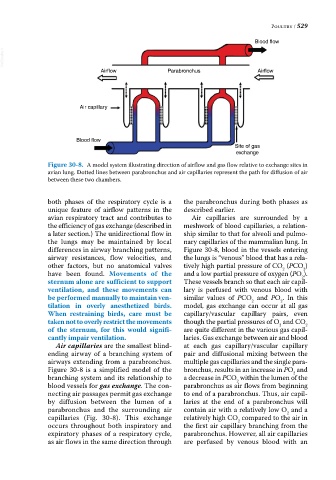Page 544 - Anatomy and Physiology of Farm Animals, 8th Edition
P. 544
Poultry / 529
Blood flow
VetBooks.ir
Airflow Parabronchus Airflow
Air capillary
Blood flow
Site of gas
exchange
Figure 30-8. A model system illustrating direction of airflow and gas flow relative to exchange sites in
avian lung. Dotted lines between parabronchus and air capillaries represent the path for diffusion of air
between these two chambers.
both phases of the respiratory cycle is a the parabronchus during both phases as
unique feature of airflow patterns in the described earlier.
avian respiratory tract and contributes to Air capillaries are surrounded by a
the efficiency of gas exchange (described in meshwork of blood capillaries, a relation-
a later section.) The unidirectional flow in ship similar to that for alveoli and pulmo-
the lungs may be maintained by local nary capillaries of the mammalian lung. In
differences in airway branching patterns, Figure 30‐8, blood in the vessels entering
airway resistances, flow velocities, and the lungs is “venous” blood that has a rela-
other factors, but no anatomical valves tively high partial pressure of CO (PCO )
2
2
have been found. Movements of the and a low partial pressure of oxygen (PO ).
2
sternum alone are sufficient to support These vessels branch so that each air capil-
ventilation, and these movements can lary is perfused with venous blood with
be performed manually to maintain ven- similar values of PCO and PO . In this
2
2
tilation in overly anesthetized birds. model, gas exchange can occur at all gas
When restraining birds, care must be capillary/vascular capillary pairs, even
taken not to overly restrict the movements though the partial pressures of O and CO
2
2
of the sternum, for this would signifi- are quite different in the various gas capil-
cantly impair ventilation. laries. Gas exchange between air and blood
Air capillaries are the smallest blind‐ at each gas capillary/vascular capillary
ending airway of a branching system of pair and diffusional mixing between the
airways extending from a parabronchus. multiple gas capillaries and the single para-
Figure 30‐8 is a simplified model of the bronchus, results in an increase in PO and
2
branching system and its relationship to a decrease in PCO within the lumen of the
2
blood vessels for gas exchange. The con- parabronchus as air flows from beginning
necting air passages permit gas exchange to end of a parabronchus. Thus, air capil-
by diffusion between the lumen of a laries at the end of a parabronchus will
parabronchus and the surrounding air contain air with a relatively low O and a
2
capillaries (Fig. 30‐8). This exchange relatively high CO compared to the air in
2
occurs throughout both inspiratory and the first air capillary branching from the
expiratory phases of a respiratory cycle, parabronchus. However, all air capillaries
as air flows in the same direction through are perfused by venous blood with an

